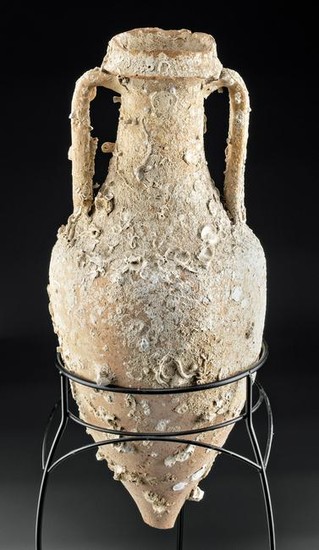Roman Pottery Transport Amphora w/ Sea Encrustations
Roman, late Republic to early Imperial period, ca. 1st century BCE to 1st century CE. A wonderful example of a pottery transport amphora with a conical base, an inverted piriform body, a rounded shoulder that tapers to a cylindrical neck, a tall, everted mouth, and a pair of handles that arch from just under the rim to the top of the shoulder. The wide, beige-hued body would have held gallons worth of precious oils used to sustain legions of Roman troops which traveled and settled in most of Western Europe and Britain. Utilitarian transport vessels like this were not typically decorated with painted designs or applied details, though some exhibit markings that denote the materials contained within. Size: 10.9" W x 26.375" H (27.7 cm x 67 cm); 36.875" H (93.7 cm) on included custom stand.
Lacking its cork and pitch stopper, the original contents of this amphora are unknown; based on the piriform shape and sizable form, it was most likely used to transport olive oil (smaller examples were meant to transport stewed fruit or salted fish, while larger ones were used for wine). Amphorae formed the basis of the Roman economy as storage vessels for transporting goods throughout the Empire, with examples found from North Africa to Britain. The conical base of this vessel is standard and was intended for storage in Roman warehouses in soft ground as well as for transport on ships by placing it through a specially designed rack and roping it through the handles to others. This vessel likely originated in North Africa, a major site of olive oil production (alongside Spain and France) in the Roman economy. This type of oil was used for a multitude of different tasks such as cooking, lighting, and, in some cases, bathing; one estimate suggests that each Roman legion consumed approximately 1,370 amphorae of olive oil per year!
Provenance: private J.H. collection, Beaverton, Oregon, USA, acquired around the early 2000s
All items legal to buy/sell under U.S. Statute covering cultural patrimony Code 2600, CHAPTER 14, and are guaranteed to be as described or your money back.
A Certificate of Authenticity will accompany all winning bids.
We ship worldwide to most countries and handle all shipping in-house for your convenience.
#151171
Condition Report: Original base point missing. Nicks to rim, handles, body, and base, with heavy encrustations, barnacles, and shell deposits commensurate with being submerged for centuries. Nice earthen deposits and sea encrustations throughout.
View it on
Sale price
Estimate
Time, Location
Auction House
Roman, late Republic to early Imperial period, ca. 1st century BCE to 1st century CE. A wonderful example of a pottery transport amphora with a conical base, an inverted piriform body, a rounded shoulder that tapers to a cylindrical neck, a tall, everted mouth, and a pair of handles that arch from just under the rim to the top of the shoulder. The wide, beige-hued body would have held gallons worth of precious oils used to sustain legions of Roman troops which traveled and settled in most of Western Europe and Britain. Utilitarian transport vessels like this were not typically decorated with painted designs or applied details, though some exhibit markings that denote the materials contained within. Size: 10.9" W x 26.375" H (27.7 cm x 67 cm); 36.875" H (93.7 cm) on included custom stand.
Lacking its cork and pitch stopper, the original contents of this amphora are unknown; based on the piriform shape and sizable form, it was most likely used to transport olive oil (smaller examples were meant to transport stewed fruit or salted fish, while larger ones were used for wine). Amphorae formed the basis of the Roman economy as storage vessels for transporting goods throughout the Empire, with examples found from North Africa to Britain. The conical base of this vessel is standard and was intended for storage in Roman warehouses in soft ground as well as for transport on ships by placing it through a specially designed rack and roping it through the handles to others. This vessel likely originated in North Africa, a major site of olive oil production (alongside Spain and France) in the Roman economy. This type of oil was used for a multitude of different tasks such as cooking, lighting, and, in some cases, bathing; one estimate suggests that each Roman legion consumed approximately 1,370 amphorae of olive oil per year!
Provenance: private J.H. collection, Beaverton, Oregon, USA, acquired around the early 2000s
All items legal to buy/sell under U.S. Statute covering cultural patrimony Code 2600, CHAPTER 14, and are guaranteed to be as described or your money back.
A Certificate of Authenticity will accompany all winning bids.
We ship worldwide to most countries and handle all shipping in-house for your convenience.
#151171
Condition Report: Original base point missing. Nicks to rim, handles, body, and base, with heavy encrustations, barnacles, and shell deposits commensurate with being submerged for centuries. Nice earthen deposits and sea encrustations throughout.



